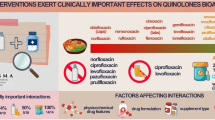Abstract
Aceclofenac is one of the most popular analgesic and anti-inflammatory drugs used for the relief of pain, rheumatoid arthritis, and osteoarthritis. To date, no intravenous preparation of aceclofenac has been developed because of its poor water solubility. In this study, to investigate its absolute bioavailability and metabolism in rats, aceclofenac was dissolved in a sterile aqueous solution containing urea (20 %) and trisodium citrate (10 %), and administered via oral (20 mg/kg) and intravenous (10 mg/kg) routes. Blood samples were taken serially, and aceclofenac and its three major metabolites (4′-hydroxydiclofenac, 4′-hydroxyaceclofenac, and diclofenac) were measured by HPLC–MS/MS. The absolute oral bioavailability of aceclofenac was approximately 15 %. Diclofenac and 4′-hydroxydiclofenac were the main metabolites in rats, in contrast to 4′-hydroxyaceclofenac in humans. The low bioavailability of aceclofenac is likely due to extensive metabolism, and bioavailability may be even lower if the drug were administered as a tablet, considering its low water solubility. This study provides complete time profiles of the plasma concentrations of aceclofenac and its metabolites in rats and highlights the difference in drug metabolism between rats and humans.


Similar content being viewed by others
References
Abderhalden, E. 1935. Handbuch der biologischen Arbeitsmethoden, vol. IV, 1353. Berlin: Urgan & Schwarzenberg.
Bort, R., X. Ponsoda, E. Carrasco, M.J. Gómez-Lechón, and J.V. Castell. 1996a. Comparative metabolism of the nonsteroidal antiinflammatory drug, aceclofenac, in the rat, monkey, and human. Drug Metabolism and Disposition 24: 834–841.
Bort, R., X. Ponsoda, E. Carrasco, M.J. Gomez-Lecheon, and J.V. Castell. 1996b. Metabolism of aceclofenac in humans. Drug Metabolism and Disposition 24: 969–975.
Kang, W., and E. Kim. 2008. Simultaneous determination of aceclofenac and its three metabolites in plasma using liquid chromatography-tandem mass spectrometry. Journal of Pharmaceutical and Biomedical Analysis 46: 587–591.
Maheshwari, R.K., and A. Indurkhya. 2010. Formulation and evaluation of aceclofenac injection made by mixed hydrotropic solubilization technique. Iranian Journal of Pharmaceutical Research 9: 233–242.
Oöpik, V., I. Saaremets, L. Medijainen, K. Karelson, T. Janson, and S. Timpmann. 2003. Effects of sodium citrate ingestion before exercise on endurance performance in well trained college runners. British Journal of Sports Medicine 37: 485–489.
Schilcher, G., H. Scharnagl, J.H. Horina, A.R. Rosenkranz, T. Stojakovic, and H. Polaschegg. 2012. Trisodium citrate induced protein precipitation in haemodialysis catheters might cause pulmonary embolism. Nephrology, Dialysis, Transplantation 27: 2953–2957.
Acknowledgments
This research was supported by the Yeungnam University Research Grants in 2010.
Conflict of interest
The authors declared no conflict of interest.
Author information
Authors and Affiliations
Corresponding authors
Additional information
Keumhan Noh and Beom Soo Shin have equally contributed to this work.
Rights and permissions
About this article
Cite this article
Noh, K., Shin, B.S., Kwon, Ki. et al. Absolute bioavailability and metabolism of aceclofenac in rats. Arch. Pharm. Res. 38, 68–72 (2015). https://doi.org/10.1007/s12272-014-0350-4
Received:
Accepted:
Published:
Issue Date:
DOI: https://doi.org/10.1007/s12272-014-0350-4




